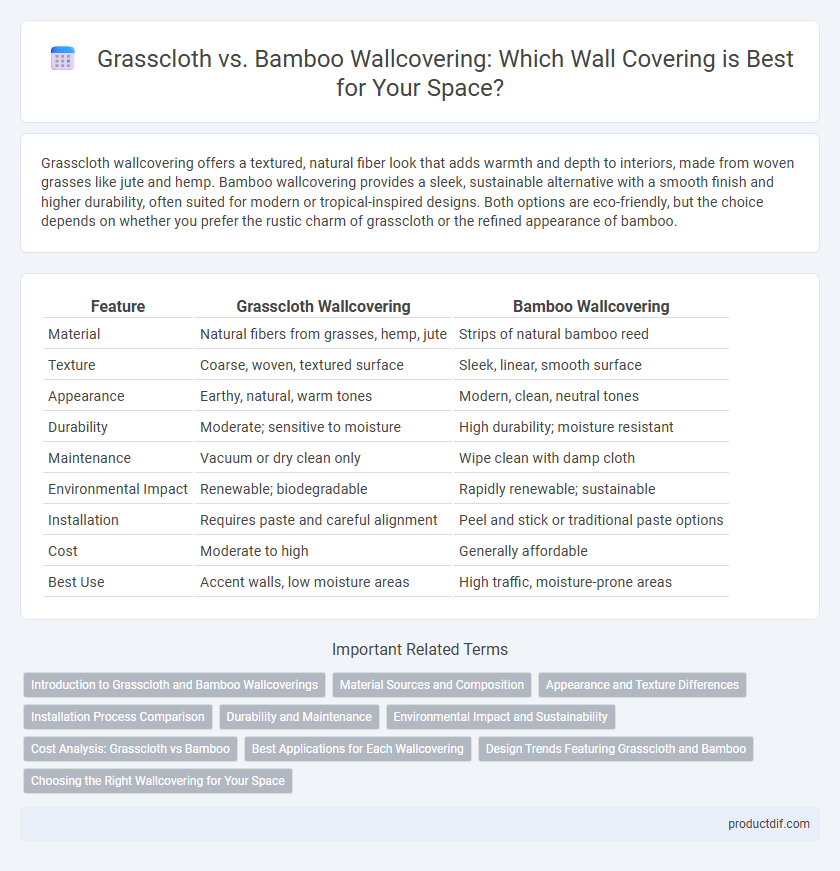Grasscloth wallcovering offers a textured, natural fiber look that adds warmth and depth to interiors, made from woven grasses like jute and hemp. Bamboo wallcovering provides a sleek, sustainable alternative with a smooth finish and higher durability, often suited for modern or tropical-inspired designs. Both options are eco-friendly, but the choice depends on whether you prefer the rustic charm of grasscloth or the refined appearance of bamboo.
Table of Comparison
| Feature | Grasscloth Wallcovering | Bamboo Wallcovering |
|---|---|---|
| Material | Natural fibers from grasses, hemp, jute | Strips of natural bamboo reed |
| Texture | Coarse, woven, textured surface | Sleek, linear, smooth surface |
| Appearance | Earthy, natural, warm tones | Modern, clean, neutral tones |
| Durability | Moderate; sensitive to moisture | High durability; moisture resistant |
| Maintenance | Vacuum or dry clean only | Wipe clean with damp cloth |
| Environmental Impact | Renewable; biodegradable | Rapidly renewable; sustainable |
| Installation | Requires paste and careful alignment | Peel and stick or traditional paste options |
| Cost | Moderate to high | Generally affordable |
| Best Use | Accent walls, low moisture areas | High traffic, moisture-prone areas |
Introduction to Grasscloth and Bamboo Wallcoverings
Grasscloth wallcoverings are crafted from natural fibers like jute, hemp, and seagrass, offering a textured and organic appearance that enhances interior warmth. Bamboo wallcoverings utilize thinly woven bamboo strips, providing a sleek, eco-friendly option with exceptional durability and moisture resistance. Both materials contribute to sustainable design trends, but grasscloth delivers a softer, tactile feel while bamboo offers a more polished, modern aesthetic.
Material Sources and Composition
Grasscloth wallcovering is woven from natural fibers such as hemp, jute, or arrowroot, providing a textured, organic surface. Bamboo wallcovering is made from thin strips of bamboo, offering a smooth and durable finish with eco-friendly properties. Both materials emphasize sustainability, but grasscloth tends to be more delicate while bamboo is moisture-resistant and stronger.
Appearance and Texture Differences
Grasscloth wallcovering features a natural, woven texture made from fibers like hemp, jute, and arrowroot, offering an organic, tactile surface with subtle variations in color and pattern. Bamboo wallcovering presents a smoother, more uniform appearance with thin, closely set bamboo slats or strips, providing a sleek, contemporary look with a polished finish. The contrasting textures highlight grasscloth's rustic, handcrafted aesthetic versus bamboo's clean, structured elegance.
Installation Process Comparison
Grasscloth wallcovering requires careful handling during installation due to its delicate natural fibers and must be hung seam-to-seam using a strong adhesive to prevent shrinking or fraying. Bamboo wallcovering generally offers a sturdier installation process, often featuring pre-pasted backing or strip rolls, making alignment and application more straightforward and durable. Both options demand precise surface preparation and acclimation to humidity levels to ensure long-lasting adhesion and appearance.
Durability and Maintenance
Grasscloth wallcovering offers a natural, textured appearance but tends to be less durable and more prone to damage from moisture and abrasion, requiring careful maintenance and occasional professional cleaning. Bamboo wallcovering demonstrates greater durability with resistance to wear and humidity, making it easier to maintain through simple dusting and occasional wiping with a damp cloth. Choosing bamboo can result in longer-lasting wall protection and lower upkeep costs compared to grasscloth options.
Environmental Impact and Sustainability
Grasscloth wallcovering, made from natural fibers like jute, hemp, and arrowroot, offers a biodegradable option with low chemical processing, promoting environmental sustainability. Bamboo wallcovering, derived from rapidly renewable bamboo grass, boasts high carbon sequestration and durability, making it an eco-friendly choice with minimal environmental impact. Both materials support sustainable interior design practices by reducing reliance on synthetic products and enhancing indoor air quality through natural composition.
Cost Analysis: Grasscloth vs Bamboo
Grasscloth wallcovering typically ranges from $50 to $150 per roll due to its handwoven natural fibers, while bamboo wallcovering usually costs between $40 and $100 per roll, offering a more budget-friendly option. Installation expenses for grasscloth can be higher because of its delicate texture requiring skilled labor, whereas bamboo panels often allow for easier application, reducing labor costs. Long-term durability and maintenance should be considered, as bamboo resists moisture and wear better, potentially lowering replacement and upkeep expenses compared to grasscloth.
Best Applications for Each Wallcovering
Grasscloth wallcovering excels in creating textured, natural accents ideal for low-traffic areas such as bedrooms, dining rooms, and feature walls due to its delicate fibers prone to damage and moisture sensitivity. Bamboo wallcovering offers greater durability and moisture resistance, making it suitable for high-traffic spaces like hallways, living rooms, and bathrooms where a sustainable, eco-friendly aesthetic is desired. Both materials enhance interiors with organic appeal, but careful selection depends on environmental conditions and usage to maximize longevity and visual impact.
Design Trends Featuring Grasscloth and Bamboo
Grasscloth wallcovering offers a textured, natural aesthetic with visible fibers that create depth and warmth, making it a popular choice in modern eco-friendly interior design. Bamboo wallcoverings introduce a sleek, linear pattern that complements minimalist and Asian-inspired decor styles, adding a subtle organic element. Current design trends highlight combining grasscloth and bamboo for layered, tactile wall treatments that emphasize sustainability and natural materials.
Choosing the Right Wallcovering for Your Space
Grasscloth wallcovering offers a natural, textured look with unique variations in color and pattern, ideal for creating warm and earthy interiors. Bamboo wallcovering provides durability and a sleek, modern aesthetic, perfect for high-traffic areas or minimalist designs. Selecting between grasscloth and bamboo depends on your space's desired ambiance, maintenance needs, and exposure to moisture.
Grasscloth vs Bamboo Wallcovering Infographic

 productdif.com
productdif.com